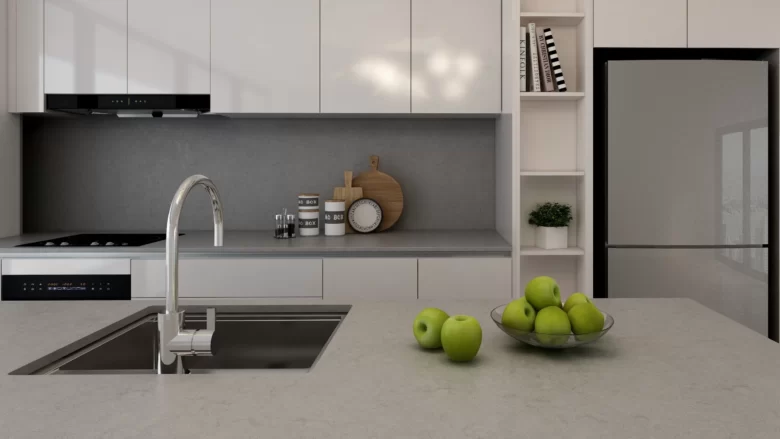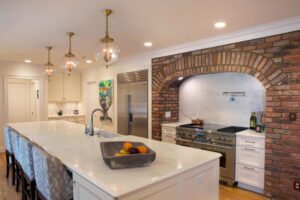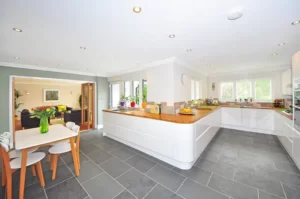The kitchen is frequently regarded as the most significant space in a home. The majority of real estate professionals concur that remodeling your kitchen is the finest approach to enhance or raise the value of your house. Major appliances are typically replaced, new flooring is usually put in, kitchen cabinets are usually replaced or refinished, and new worktops are usually installed. Let’s concentrate on the final step, which involves switching out your old countertop material for a new one.
Of course, it’s not just a matter of heading to the store to select new kitchen countertops. You must first determine how much money you wish to spend. You should also evaluate how much time and work it will take to keep your new countertops in good condition. Finally, consider carefully about the design and appearance you want for your kitchen. Whatever countertop you choose, it will be the center point of the room.
Granite is the first sort of countertop that comes to mind for any concerned kitchen remodeler. However, there are other countertop materials to pick from, and granite is just one of them. Those wishing to renovate their kitchen can now choose from tile, stone, acrylic, concrete, stainless steel and laminate, and even wood!
Granite:
Let’s start with the most common: granite. Granite countertops are the most popular, but they are also the most expensive. Why? Aside from its lovely surface, granite is also incredibly heat and scratch resistant. Granite countertops are extremely sturdy and long-lasting. Granite countertops will never go out of style, and installing granite slabs can significantly raise the value of your property. shortcoming? Aside from the price, granite is a natural stone that is porous. To avoid staining, a sealer is essential. Instead of huge slabs, granite tiles might be used. Tiles offer significant cost savings. It is critical not to utilize a granite surface as a cutting board since it will dull the surface (and possibly ruin a knife or two).
Concrete:
Concrete is used for more than just sidewalks and roadways. Concrete countertops, like natural stone, can be colored and polished to a smooth, glossy surface. Counters can be cast in the factory or on-site. Concrete is highly porous and, like granite, must be sealed on a regular basis to prevent stains. It is available in any shape and thickness. Concrete is also resistant to heat and scratches. Countertops are available in a variety of colors and textures. What are the disadvantages of concrete? The essential equipment is not the sole form of protection required. Sealers must be waxed every one to three months to avoid discoloration and water damage, so upkeep can be time-consuming. Cutting through a concrete surface will leave a mark. It is also very expensive.
Wood:
Wood countertops, also known as Butcher Block Countertops, are often formed from bonded together pieces of maple or oak. However, practically any hardwood can be used to make a counter top. Bamboo countertops are the newest design trend! Wooden counters have a warm, appealing appearance and may be found in a range of colors and textures. It’s ideal for individuals who want to cut right on the counter. Deep wounds, scratches, and markings can be sanded down and resealed. It is simple to set up and reasonably priced. shortcoming? The wood is not very hard and will easily burn, scrape, or dent. Because of the continual exposure to water, wood around sinks can distort or discolor. It should also be sealed on a regular basis.
Solid Surfaces/Acrylic:
Solid Surface countertops are designed specifically for each application. These surfaces are strong, waterproof, easy to clean, non-porous, and even mold and bacterium resistant. Sanding can be used to remove cuts or scratches. Disadvantages include the inability to handle hot cookware, the high cost, and the substantial weight necessary for a solid cabinet base (equivalent to natural stone). Some people object to the material’s plastic or “fake” appearance, but it is available in a range of hues.
Stainless Steel:
The dining area is generally the first thing that comes to mind when you think about stainless steel kitchen counters. But most eateries utilize this material for a reason. Durability, stain and water resistance, easy maintenance, and a wide range of size and form options are just a few of the benefits. It is very simple to clean, and you can lay a hot plate or pan on it without worrying about damage it. Cons: Many individuals dislike the “industrial” style. It can be fairly costly to create. When you cut it, it leaves marks and can dent easily. It is critical that the surface is at least 18 gauge and includes 8% to 10% nickel.
Tiles
For many years, glazed ceramics and tiles have been popular in kitchens. It is available in a wide range of colors, forms, and designs. Tiles range in size from one square inch to six square inches. These tiles are not only long-lasting but also have the same heat and scratch resistance as granite. Ceramic tile is typically more expensive than tile, but it is also more durable and the most difficult to fire. Do you prefer disadvantages or tiles? It is more expensive than laminate alternatives and has a tendency to disintegrate. Placing the tiles together results in grout between each tile, which can soon get dirty. It requires more upkeep to remain in good condition. Because of the grout concerns, the potential of the tiles to shatter and chip easily, and the total cost, it is preferable to leave the installation process to an expert.
Other Natural Stones:
Aside from granite, there are various different stone surfaces that can be used for countertops. Surfaces such as quartz, marble, limestone, soapstone, and slate are extremely popular today. Marble is smooth and cool, making it ideal for immediately preparing food on its surface. It is less durable than granite and requires more seal care to prevent discoloration. Slate is highly durable and has such a distinct finish that it can truly stand out in the kitchen. Because slate has been utilized as a roofing material, less waterproofing protection is required, but some upkeep is still required. Because limestone is very porous, spills must be cleaned up soon to avoid stains. It has a naturally worn appearance that deepens and darkens with age. Natural quartz resembles slate but is less susceptible to discolor or scratch. Engineered quartz is also becoming increasingly popular, although at a considerably greater cost (engineered materials include quartz composite items that mix epoxy resin, polymers, and small stones or pebbles to give them a unique look and feel).
Conclusion:
When it comes to kitchen remodeling, upgrading old worktops can significantly improve the overall appearance and value of your property. With so many countertop materials to pick from, you can always find one that fits your budget, maintenance needs, and aesthetic preferences. Granite countertops are a popular choice because of their beauty and durability, but they may be costly. Concrete countertops are available in a variety of shapes and colors, but they must be sealed on a regular basis. Wooden countertops offer a warm and inviting appearance, but they must be cared for properly to avoid damage. Solid surface/acrylic is non-porous and easy to clean, however stainless steel is durable and has a sleek appearance. Ceramic and porcelain tiles are adaptable in design but require regular upkeep. Other natural stones, such as quartz, marble, limestone, soapstone, and slate, also provide distinct possibilities with variable durability and maintenance requirements. Overall, the correct countertop material may transform your kitchen into a beautiful and useful space.
FAQs
1. How much do granite countertops cost?
Because of its inherent beauty and durability, granite countertops are more expensive than other materials. However, there are less expensive options, such as granite tiles.
2. What is the most popular material for kitchen countertops?
Because of their beauty, heat resistance, and durability, granite countertops are the most preferred choice. However, there are plenty alternative options.
3. Are tiles a good choice for kitchen countertops?
Ceramic and porcelain tiles, like granite, are long-lasting and heat-resistant. They do, however, necessitate routine maintenance since the grout between the tiles can become dirty and the tiles themselves can chip or shatter.



